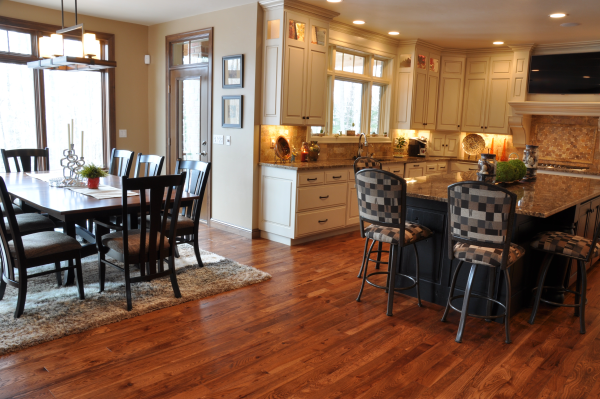Natural hardwood colors vary tremendously between species, and you also have the option of staining to get virtually any color you want.
With such a wide range of options, choosing a hardwood color can be a bit overwhelming. But there’s no need to stress—by following each of the following five steps you can be sure to get the right color for your floor.
1. Decide on the feel you’re after.
You need to be sure of the mood you’re trying to achieve with your hardwood flooring. Your decision about hardwood colors should be made with this overriding goal at the top of your mind.
Of course it’s all in the eye of the beholder, but darker colors generally create a cozier mood while lighter colors produce a roomier feel.
Another key choice is whether you want a natural feel. If you do, heavy stain color probably isn’t for you, although a light stain may be just fine.

2. Coordinate hardwood colors to your furnishings and to other rooms.
Choosing colors to complement your existing furniture as well as trim and cabinets is key. Achieving a nice contrast from the floor to the trim and cabinets that surround it is a great way to add interest. If you have dark furniture, you may want light flooring so that the floor and the furniture don’t blend together too much. As a rule of thumb, try to keep the floor and trim/cabinets off by at least two shades, either darker or lighter.
3. Consider the maintenance.
Darker woods tend to show scratches and dust more than lighter colors—a fact that could be important to you, particularly if you expect the floors to see rough usage (pets, small children, etc.).
4. Choose a color you love!
Ultimately, choosing hardwood colors comes down to what you like. Even if a color makes interior-design sense, if may not be the right choice. You’re the one who will live with the floor, so make sure the color you choose is one that excites you.
Fortunately, hardwood colors are much more varied than simply “dark,” “light,” or “medium.” You can decide you want a color within one of those ranges, but still have plenty of choices, because each species has a distinct color tone. For example, a lot of oak flooring has a warm yellowish tone that many people fall in love with.
5. Work with an established hardwood floor company.
Working with a hardwood floor company that’s dedicated to customer service (like us!), you can review all your color choices, get expert advice, and ask any questions you have. This step will help you complete all the other steps.















